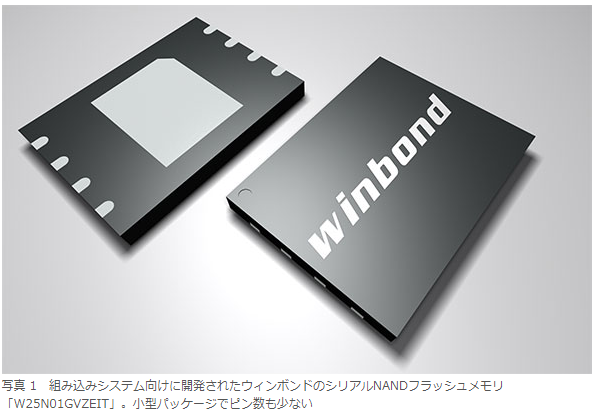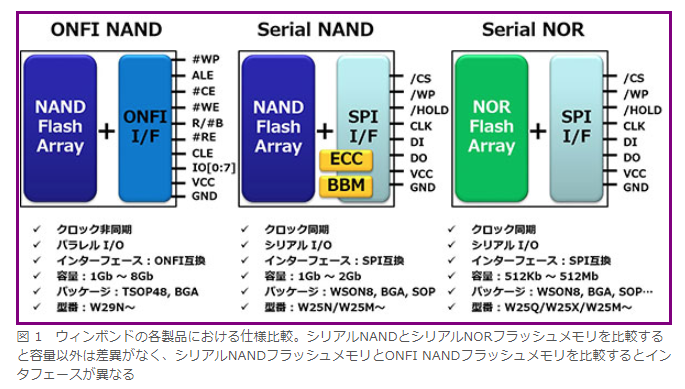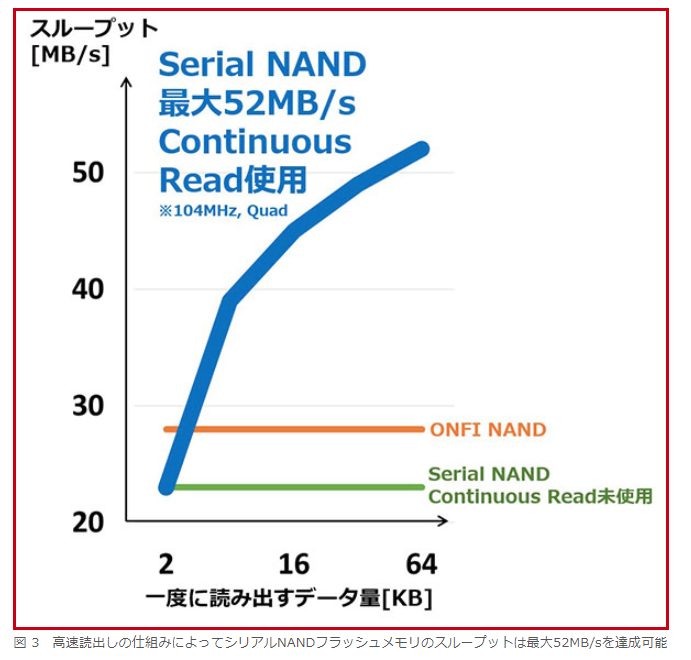Introduction
Embedded systems with increasingly sophisticated functions are in demand for large-capacity memory, and NAND flash memory is starting to replace NOR flash memory. We will explain why serial NAND flash memory has started to be chosen for embedded systems and points to note when implementing it, using Winbond's "W25N01GVZEIT" as an example.
Non-volatile memory trends for embedded systems at a turning point
In recent years, the scale of software implemented in embedded systems has increased rapidly. Against the background of IoT, the main reasons are the introduction of the essential network connection function, high-definition GUI, and AI such as voice / image recognition. Therefore, there is a demand for even greater capacities in non-volatile memory that stores software for embedded systems. As a result, the movement to replace NOR flash memory with NAND flash memory has begun.
When using NAND flash memory in embedded systems, until now, ONFI NAND flash memory conforming to the parallel interface ONFI (Open NAND Flash Interface) was common. However, recently, some MCUs/SoCs do not have an ONFI interface inside.
In this case, eMMC is a candidate, but in general, some low-end/middle-end MCU/SoC products do not have an eMMC interface, so connection may not be possible. Also, since eMMC is configured by packaging multiple chips, the price and power consumption are higher than those of ONFI NAND flash memory. Therefore, eMMC is not optimized for embedded systems.

Therefore, serial NAND flash memory is attracting attention now. Picture 1 shows Winbond's serial NAND flash memory "W25N01GVZEIT". The interface is SPI compliant, has as few as 8 pins, and has a small package of 8 x 6mm.
Unlike eMMC, serial NAND flash memory does not have a controller IC. Therefore, in order to make full use of serial NAND flash memory, it is necessary to perform processing such as ECC (Error Checking & Correction) and Bad Block on the MCU/SoC side. This section explains how to use serial NAND flash memory.
3 Reasons Why Serial NAND Flash Memory is Best for Embedded Systems
Figure 1 shows a comparison of the specifications of Winbond's flash memory products. Let's see why serial NAND flash memory is the perfect fit for modern embedded systems by comparing it with other flash memory products.

1. 8-pin 8×6MM small-size package with few pins
Traditionally, ONFI NAND flash memory has been commonly used when large non-volatile memory is required in embedded systems. However, the standard package for ONFI NAND flash memory is the 20x12mm TSOP package, which has 48 pins and is not suitable for embedded systems with severe component mounting area limitations. As shown in Figure 2, the serial NAND flash memory is a small 8x6mm WSON package with 8 pins.

2. High speed read up to 52MB/S
Unlike ONFI NAND flash memory, serial NAND flash memory implements a mechanism for high-speed reading. Winbond's serial NAND flash memory "W25N01GVZEIT" can operate at a maximum clock of 104MHz. Quad SPI operation, which reads and writes data using four signal lines, is also possible. In addition, a mechanism called Continuous Read is implemented to reduce the number of command and address inputs by automatically reading data up to the final address once the specified address is entered. As shown in Figure 3, all of these can be used together to achieve a maximum throughput of 52MB/s.

3. Equipped with ECC and bad block management assistance function
Comparing serial NAND flash memory and serial NOR flash memory, there are minor differences such as read and write command sequences, but there are no major differences other than capacity. This is because the specifications are compatible so that serial NOR flash memory can be replaced with serial NAND flash memory.
However, proper use of NAND flash memory requires processes such as bit error detection and correction (ECC) and bad block detection and management. Winbond's serial NAND flash memory "W25N01GVZEIT" is equipped with ECC by hardware logic, so there is no need to worry about bit errors. It also has a dedicated non-volatile area for managing bad block addresses, and is equipped with functions for safe use of NAND flash memory.
Bit errors and bad blocks do not occur in NOR flash memory and are unique to NAND flash memory.
In the next article, I will explain what each phenomenon is and how to deal with it.
Click here for related links
Inquiry / Quotation
If you have any questions, samples, or requests for quotations regarding this product, please contact us using the form below.
Back to Winbond Manufacturer Information Top
If you want to return to Winbond manufacturer information top page, please click below.
